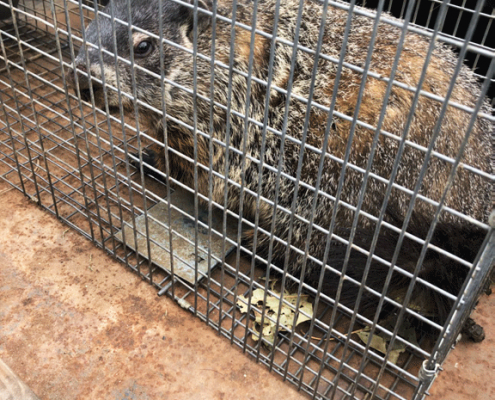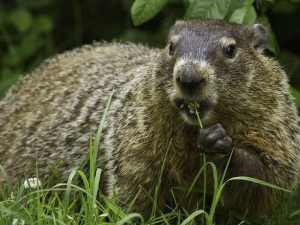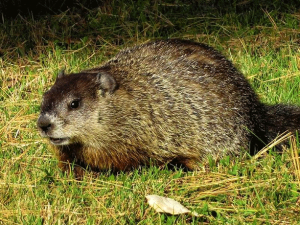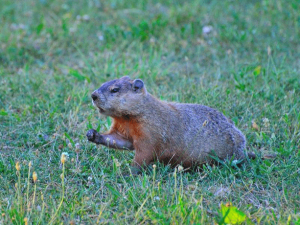
Groundhog solutions
Groundhogs Description

Groundhogs are a large rodent within the squirrel family. They are also known as woodchucks, and they live throughout North America. Groundhogs are known for the tradition of groundhog day that takes place in America. On this holiday, Americans predict when Spring will start based on whether the groundhog sees its shadow or not.
Groundhogs are also commonly referred to as land beavers and whistle pigs. They are known for being skilled at swimming and climbing. These ways of moving can help groundhogs escape from predators who can’t swim or climb.
Use This Information to Help Identify Groundhogs
Groundhogs are interesting animals, and they have some cool facts that are tied to them. Unfortunately, they are known for causing damage to property due to their nature. Use these facts to identify groundhogs if they are causing damage to your property, and have the issue dealt with so that the damage does not become too extensive.
Groundhogs spend most of their time in burrow systems underground. The burrow systems are usually dug in dry, well-drained soil. A groundhog’s average lifespan will typically range from 3-6 years in the wild. The animal will typically live in transitional areas, which are areas where woodlands or forests meet well-vegetated areas.
Groundhogs are found in most of the areas within the central and eastern United States. They can also be found in some areas of Alaska and Canada.
Typically, groundhogs build their burrows in areas with nearby cover. Cover can include things such as structures, home foundations, fencerows and hedgerows, and trees.
Groundhogs have short limbs and a long tail, similar to squirrels, but they have a larger body. The groundhog is the largest member of the squirrel family. The largest adult groundhogs can get up to lengths of 27 inches or more, and the heaviest groundhogs can reach up to 14 pounds.
On average, groundhogs are about 20 inches long. Their tails are about 6-7 inches long, and they have short, but strong legs. The average weight of a groundhog will range from 6-12 pounds.
Their fur can vary in color, appearing to be dark brown, grey, or a reddish-brown. Their fur looks very similar to a squirrel’s fur, so you can see the relation to the two animals in that respect. You may be able to spot a groundhog standing on its hind legs, which is how they try to fend off predators.
Groundhog tracks should be fairly easy to spot. If you think there are groundhogs damaging your garden, you should look in that area for tracks that are spaced between 4 and 12 inches apart from each other.
The paw imprints of groundhogs will have 4 toes on the front paws, and 5 toes on the back paws. The additional toe on the back paws is lower than the rest of their toes. Groundhogs also have curved claws, which make it easier for them to dig and burrow underground. Their front and rear paws will have curved claws on the ends of each of their toes. Typically, you will find the front paw track immediately followed by the rear paw track.
The scat of groundhogs will usually be in a round oval shape, in the form of pellets. Groundhogs will typically defecate in toilet chambers that they make for themselves in the ground. The droppings are medium-sized and will be dark brown or black in color.
Droppings of groundhogs are known to carry various diseases and can contaminate water if it comes in contact with it. Groundhogs can carry tularemia, as insects can infect them with it. Humans can actually contract tularemia if they come in contact with groundhog droppings.
There are many different sounds that groundhogs make that you should look out for. When groundhogs are angry or worried, they make a chattering sound with their teeth.
When groundhogs are startled, they make a low pitched noise that sounds somewhat like “chuck-chuck”. Lastly, groundhogs are sometimes referred to as whistle pigs because they are known for making a shrill whistling noise that alerts fellow groundhogs of nearby predators.
One of the main reasons that groundhogs can be a threat to your property is their diet. To get the best understanding of why groundhogs can cause trouble, you need to look into what types of food they eat and what their eating patterns are.
Groundhogs are typically herbivores, and their diet revolves around garden crops. Groundhogs may also eat insects and worms. Groundhogs love to eat greens, trees, vegetation, fruits, and insects.
So just remember, the more of these foods that you have in your yard or garden, the more likely groundhogs will be attracted to your property.
Some things that you should look out for to determine whether groundhogs have been present on your property include sharply cut plants, crops that are completely missing, and excess weeds in a particular area.
The eating patterns of groundhogs can vary based on what season it is. One of the main differences is the time that groundhogs eat. During the spring and the fall, groundhogs will feed during the afternoon. During the summer, groundhogs will eat early in the morning and in the late afternoon.
During the winter, groundhogs don’t eat because the crops they typically go after will not be around. To prepare for this, groundhogs will build up fat reserves so that they can go into hibernation. The hibernation period for groundhogs lasts from October to February.
Typically at the end of the hibernation period in February, groundhogs will have lost around half of their body weight since their body will be feeding off of excess fat. So now, groundhogs will start feeding again to gain that weight back and start building up a reserve for the next hibernation period.

Groundhogs are known for causing damage to crops, gardens, home foundations, and electrical wires. While groundhogs are cute, they can cause a major headache for homeowners if they become apparent on your property.
Damage to Crops
Groundhogs cause lots of damage to crops because their diet consists of crops. They are herbivores, and they love to eat greens, trees, vegetation, fruits, and insects. Groundhogs can sharply cut plants, leave crops completely missing, and create excess weeds in a particular area.
They also eat grass and clover, and their burrows can disrupt how crops grow in your garden. The burrows are often dug directly underneath vegetation and are covered up by leaves and sticks as the groundhogs try to hide them.
Damage to Home Foundations
If you do not take control of your groundhog problem, their burrowing can lead to damage within your home’s foundation. Their tunnels have the ability to break parts of your building’s foundation, which can prove to be costly to fix.
Damage to Electrical Wiring
Similar to the way that groundhog’s burrowing can cause damage to your home’s foundation, it can also cause damage to any electrical wiring underground. This is because if any wiring is in their way, they are going to chew through it.
Damage to Irrigation Systems
The burrowing of groundhogs can also cause damage to any irrigation system that you have set up in your yard. Similar to the electrical wire, groundhogs can chew their way through your irrigation system if it is in the way of their tunnel.
Not only does all of this damage have a cost associated with it, but a headache as well. Setting up a new irrigation system will take time, and then you have to hope that the groundhogs will not chew on the new one that you set up.
The Bottom Line on Groundhog Damage
While groundhogs can look very cute, they often cause a lot of damage to properties. If you are wary of groundhogs infiltrating your property, you should look for signs of the animals, such as tracks, droppings, and sounds.
There are multiple strategies of dealing with groundhogs, and your ideal strategy may come down to a combination of different methods. Some of the deterrents will prove to be more costly, such as setting up an electric fence, though that would make sure that the animals don’t come to visit you again.
Other methods of deterring groundhogs are easy to do with household items, such as squeezing lime juice on the ground to burn their feet or sprinkling talcum powder in your garden. You will need to determine which types of methods to deal with groundhogs will be best for your situation, and if you are unsure, it would not hurt to get in contact with an expert.
Typically, groundhogs do not come in contact with humans and they are not a major hazard. There are still some things to keep in mind if you are dealing with groundhogs on your property, or want to educate yourself on the animal in case you ever come in contact with one.

Groundhogs Can Carry Rabies
One of the main concerns you should have with groundhogs is that it is possible they are carrying rabies. While it is rare that this happens, it can make a groundhog more aggressive and dangerous. Rabies can be fatal to humans who do not seek a vaccination.
Some signs that you should look out for are a lack of coordination, seizures and trembling, foaming around the mouth, odd noises, change in eating habits, and aggressiveness. If you see a groundhog with any of these traits, they are most likely rabid.
Groundhogs May Bite When Threatened
Groundhogs have large front teeth, and like other animal bites, theirs can prove to be painful. While it is rare that groundhogs carry rabies, if you do happen to get bitten by one, you should always get it checked out by a health professional as soon as possible.
Some instances that may cause a groundhog to bite include being caught in a trap, when they are frightened, when they are trying to escape, and if they come in contact with another animal. While you should be mindful of this, just know that groundhogs are more likely to run away and hide then they are to bite you.
Be Wary Of Groundhog Droppings
One sign that you may have groundhogs in your yard is by finding their droppings. Though groundhogs usually go in a toilet chamber that they make in their burrows, it isn’t impossible to spot their droppings on the ground.
It is possible that their droppings are carrying various diseases, such as tularemia. Groundhog droppings do have the ability to contaminate water if they come in contact with it. Humans can actually contract tularemia if they come in contact with groundhog droppings, so you need to either handle the droppings safely or contact an expert to do it for you.
Some steps that you can take to clean them up safely include wearing heavy latex gloves, spraying the droppings with disinfectant, disinfecting the surrounding area when cleanup is complete, and washing your hands immediately upon completion.
Not The Biggest Threat, But Use Caution
To wrap up, groundhogs are not the biggest threat to humans, but you still need to be mindful of risks when you are handling a situation involving groundhogs. Keep in mind that it is possible they have rabies, so get yourself comfortable with the common indicators of the disease.
Also, the droppings of groundhogs can be a potential place for dangerous infectious agents to live. If you are comfortable removing droppings on your own, make sure to follow all of the important steps to keep yourself safe. If you are uncomfortable conducting the clean up on your own, reach out to an expert for some help!
